Home > About Us > Corporate Social Responsibility > Sustainability Report > Sustainability Report 2008 > 1. Environmental Activities & Performance (2)
 1. Environmental Activities & Performance (2)
1. Environmental Activities & Performance (2)
| Building a Recycling-based Society |
| The Kobe Steel Group is involved in wide-ranging businesses covering materials and industrial machinery. With regard to steel, the primary raw materials of iron ore and coal are imported from overseas. We also supply environment-related equipment designed to help build a recycling-based society, thereby contributing to resource recycling. To make effective use of limited resources we are striving to reduce to the minimum wastes generated through these activities at our plants and works. We re-use and recycle byproducts as far as possible; for example slag from steelmaking is used as a raw material for cement. In this and many other ways we are active in building a recycling-based society. |
| Reducing Waste and Promoting Recycling |
| In 2007, the Kobe Steel Group generated approximately 4.81 million tons of byproducts, of which 98.4% came from the Iron and Steel Sector. At steel works we have accelerated the recycling of slag and dust generated in steel-making processes. Since 1992 a comprehensive Action Program to Recycle Waste has been formulated for all plants and works, and we are continuing to promote waste reduction and recycling. Recycling rates for 2007 were 93.7% for all of Kobe Steel's manufacturing facilities and 93.0% for Group companies overall. In 2007, for the overall Group 290,000 metric tons of waste was disposed of in landfills. This included some slag that could not be recycled, and some dust that had been set aside for recycling but was ultimately disposed of. We will continue to implement the Voluntary Action Programs set forth by the various trade associations and work further toward developing recycling technologies and holding down generated wastes, in order to reduce the quantity of waste disposed of in landfills. |
| Waste Generation by Sector (including Group companies) | |
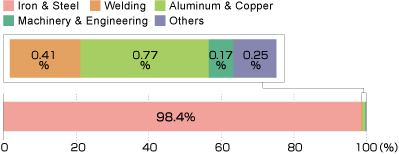
| Volume of Waste, Recycled Volume & Recycling Rate (Non-consolidated) | |
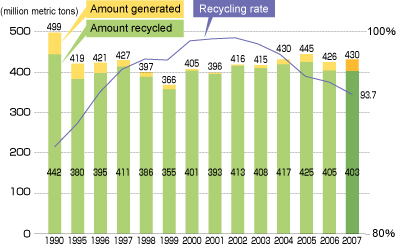
| Voluntary Action Programs Voluntary Action Programs in Industry (April 2008) |
|
|
| Zero Emission Activities at Works |
| At all works and plants Action Programs have been formulated to cut volumes of wastes destined for landfill, and continuing efforts are being made toward greater re-use and recycling. |
| Iron and Steel Sector | |
| Recycling Rate (Kakogawa Works) | |
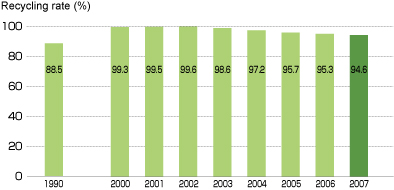
| Recycling of waste materials At the Kakogawa Works, we have been running zero-emission activities to reduce to zero the quantity of Works waste for final disposal since 1997. In real terms this means finding effective uses for used refractories, waste oil and sludge. Dust is turned into cement material, and sludge with a low iron content is used for decorative bricks. We have also developed a recycling technology for dust with high zinc content, which was previously difficult to recycle, and are working in many other ways toward making the steelworks a zero emission facility. At eco-stations, we collect and separate glass bottles, aluminum cans and similar garbage for recycling. |
| Slag Recycling The Kobe and Kakogawa works generate approximately 2.1 million metric tons of blast furnace slag and 900,000 metric tons of steel slag annually. Both types are recycled into cement material, roadbed material and other uses. Blast furnace cement made from finely powdered slag is more effective than regular cement in controlling the alkali-aggregate reaction. It can also save energy during cement production and emits less CO2, and is therefore popular with customers. Moreover, fine aggregate for concrete made from granulated blast furnace slag is used as a substitute for natural sand, and so helps conserve natural resources. |
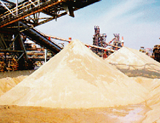 Granulated slag yard |
| Fly Ash Recycling Almost all the ash generated from coal-fired boilers can be recycled as cement material and composite roadbed material. At the Kakogawa Works, in order to utilize the finest fly ash, pelletizing equipment has been installed to make steam-cultivated spherical pellets called ashstone. Currently, ashstone is utilized as a road material. In December 2005 it was listed on the New Technology Information System (NETIS), a database for technologies for the public sector. |
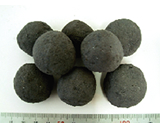 Ashstone |
| Foundry Sand Recycling At the Takasago Works, we are regenerating and re-using foundry sand used in mold manufacture with sand recycling equipment. Because of increased production in recent years and breakdowns resulting from aging facilities, sand recycling capacity was not able to keep pace and the quantity disposed of as industrial waste was growing. Through QCC activities we have reduced breakdowns, improved the operating conditions of our facilities and increased recycling capacity, in order to cut the quantity of sand for disposal. |
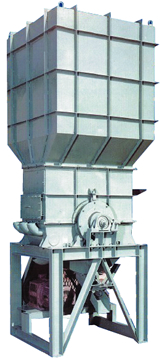 Sand recycling equipment |
| Steel Mill Dust Recycling Steel mill dust generated at steelworks is difficult to recycle, and has usually been disposed of in landfills. But Kobe Steel has applied the FASTMET® Process to recover the dust and turn it into direct reduced iron, making economic, efficient recycling possible. |
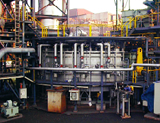 FASTMET® Plant |
| Waste Plastic Recycling In accordance with the Container and Packaging Recycling Law, Kakogawa Works accepts waste plastic collected not only within the works but also from outside, and uses it as blast furnace reductant. Because chlorine damages the blast-furnace refractory and corrodes steel structures, only low-chlorine waste plastic could be used and the waste had to be sorted. But in April 2004, Japan's first commercial dechlorination facility for waste plastic was installed, making it possible to use more than 75% of the waste plastic as reductant. The chlorine removed is turned into hydrochloric acid, which is used in the pickling line. In fiscal 2007, Kakogawa Works recycled approximately 150 metric tons of waste plastic. |
| Welding Company | |
| At the Welding Company, we recycle steel waste and scrap as raw materials for steel powder. We also use waste oil, sludge and waste flux as materials in cement. Furthermore, we use stretch packaging for our products to cut down on the use of cardboard. |
| Aluminum and Copper Company | |
| The Moka Plant has installed two melting furnaces for scrap, improved the yield ratio during melting, and reduced the volume of impurities (aluminum dross) during aluminum melting. Furthermore, the plant operates two arc furnaces to improve the recovery rate of aluminum dross. The remaining ash, as a result of R&D efforts, is effectively recycled as cement material. Most of the residual from aluminum dross is no longer disposed as landfill, resulting in a recycling rate of 93.3% in fiscal 2007. Also the bricks and debris generated from furnace repairs are precisely sorted by machine to be recycled as road bed material. At the Chofu Works an arc furnace is in operation for recovering aluminum dross and efforts have been made to recycle copper sludge, a material that was previously found difficult to deal with. As in 2006, the recycling rate for fiscal 2007 was 99.9%. At the Daian Plant, casting waste sand is recycled as a cement material. |
| Recycling Rate at the Moka Plant | |
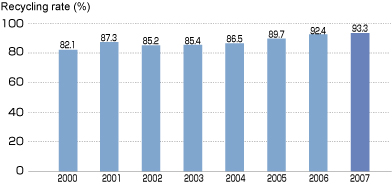
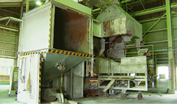 Arc furnace at Chofu Works |
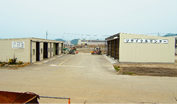 Recycling center at Chofu Works |
| Machinery and Engineering Company | |
| All the industrial waste generated at the plants is carefully sorted for re-use, either as recycled resources or as a heat source in cement production. Also, we are promoting the use of steel or plastic returnable containers for shipping some of our products. |
|
|||
| Group Companies | |
| Group companies are working to separate wastes, re-use resources and recycle in order to reduce volumes of industrial waste for landfill disposal. |
| Examples of Activities | |
|
| Utilizing LP gas canisters |
| Shinko JFE Industrial Co., Ltd. manufactures gas canisters and sought ways to reuse gas canisters that had been disposed of as scrap to make effective use of resources. From their rounded shape and their strength, they were found suitable to be made into plant containers and umbrella holders that are distinctive compared with existing products. These recycled goods were certified as 'Tottori Prefecture Authorized Green Products'. Green Products are made out of waste or intermediate materials and meet set criteria for safety and recycling. |
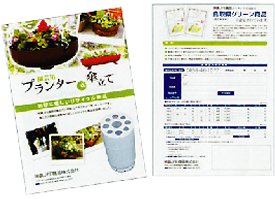 Green Products pamphlet |


